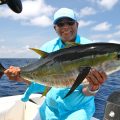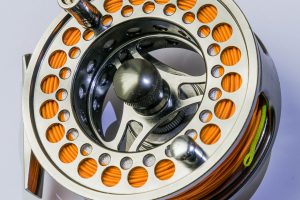
Catching yellowfin tuna is no doubt an exciting achievement,especially when you find the largest of them. The yellowfin tuna come indifferent sizes from large to “we’ve got to get a bigger boat”. Finding the fish is not a hard thing to do but catching them can be a different topic. If you familiarize yourself with the different yellowfin tuna fishing techniques, you might be ahead of the game. Yellowfin like to spend most of their time idling far below the water surface and will occasionally rise to feed. These fish like the warm waters and are mostly in enormous schools even as they chase after bait. They can be caught under schools of porpoises as they quite often chase them around. Even after catching a yellowfin, things don’t always get easier,as these fish pull hard for their size. All the same, here are some of the techniques you should apply if you are after the yellowfin tuna:
Yellowfin Tuna Fishing Techniques
1. Go deep
As stated earlier, yellow fin tuna fish spend most of their time below the surface, and if you have to get them when they are not feeding,it means that you have to cast your bait where they are. This is something you can do by deploying a swimming plug deep under your boat with a Z wing. By doing so, you eliminate the association between the lure and your boat, and you can get the bait where the yellowfin tuna is. You don’t even have to use weights to keep the lure down; the Z wing should be enough. You may need a depth sounder to give you a better idea of where to palace your lure. The good thing about fish when they are deep below the surface is that they are not very skittish and will always want to take a bite.
2. Be perfect when tying your knots
Half circles and curly Q’s can let you know whether you’ve tied bad knots. A tiny half-circle implies that your knot cut itself on the eye of the hook, while a curly Q is an indication that the knot unraveled. Bad knots make you lose you catch, but the good thing is that they are also easy to avoid. If you have had a bad-knot experience before, it’d be a good idea to learn several new knots. All you need to do is focus on one knot and practice it for 5 minutes each month during the non-fishing season. Try not to learn different knots for the same application. That’s unnecessary because all good knots will always work correctly while bad knots fail all the time. Just choose one know and perfect on it.
3. Go airborne
Baits used on kites can help you make a catch when no other technique will. Live baits produce frantic sounds cannot be ignored by most fish species; the Yellow fin tuna included. Using a kite helps you stealthily deploy your bait, increasing your chances of getting a strike, especially when in the path of feeding tuna. Live baits produce the best results, but it’s not paramount that you use them. You can use dead fish if you consider several hacks such as pinning the wings of flying fish open. Another hack that works well most of the time is flying your kite far away from the boat as you hold the bait in your hand. Once the release pin and kite are far enough, you then toss the bait overboard and then reel as fast as you can. This makes the lure move across the surface and away from the boat like a fish that is fleeing,drawing a strike in most of the cases.
4. Be “chummy”
Unlike other techniques, being chummy as you try to catchyellow fin tuna can work wonders, and it’s a lot of fun as well. Using this method, you try as much as you can to bring the fish extremely close to the boat, making it an exciting and productive way of making your catch. You will need live bait for this method, but even cut-up chunks of bait fish can produce similar results. Once you’ve found the yellow fin, you might want to go into stealth mode. You should then get a steady flow of bait, whether alive or dead,to lure the fish towards the boat. This method works amazingly if your boat is not moving or making any noise. You should then drive the hook into the live or dead bait and let it drift with the other chunks. You’ve got to pay a lot of attention not to put unnecessary pressure on the hooked bait, or else it will look unnatural. If the tuna are feeding close to where you are, your stream of bait will attract their attention almost every other time.
5. Drop back
This method works like the deep-fishing method in making the tuna think that the bait and your boat are not related at all. With this method, you have to cast the bait far away behind the boat but be very alert when waiting for a bite. This is in consideration that sharks love yellowfin too and will get your catch first if you are not fast enough. The trick here is to wind in as fast as you can once you get that bite on.
You’ve got it now
These five yellow fin tuna fishing techniques will come in handy if you are after landing a fantastic catch. All you need to do now is make a good plan, then set a date and sort your crew. Be as prepared as you should be, and then head out for a great day. You will be amazed by how well these techniques work. Just don’t forget to get a big boat.












Pingback: How to make chum for Yellow fin tuna | Reel Fishing Guru
Pingback: Best Tuna Lures | Reel Fishing Guru